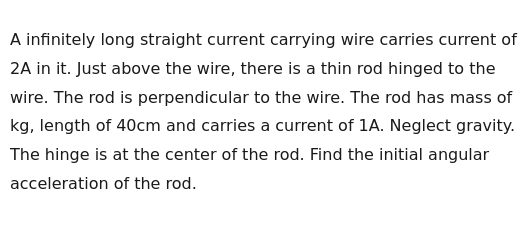Question
Question: A infinitely long straight current carrying wire carries current of 2A in it. Just above the wire, t...
A infinitely long straight current carrying wire carries current of 2A in it. Just above the wire, there is a thin rod hinged to the wire. The rod is perpendicular to the wire. The rod has mass of kg, length of 40cm and carries a current of 1A. Neglect gravity. The hinge is at the center of the rod. Find the initial angular acceleration of the rod.

The question is missing the mass of the rod and the distance of the hinge from the wire. Hence, it cannot be solved.
Solution
The problem requires calculating the initial angular acceleration of a current-carrying rod due to the magnetic field of a long straight wire. The angular acceleration (α) is given by τ=Iα, where τ is the net torque and I is the moment of inertia.
-
Torque Calculation: The magnetic field produced by the long wire varies with distance. Since the rod is perpendicular to the wire and hinged at its center, different segments of the rod are at different distances from the wire. This results in a non-uniform force distribution along the rod, leading to a net torque. The formula for this torque depends on the currents (I1,I2), the length of the rod (L), and crucially, the distance of the hinge from the wire (y0).
-
Moment of Inertia Calculation: For a thin rod hinged at its center, the moment of inertia is I=121mL2, where m is the mass of the rod.
The problem statement provides values for I1, I2, and L, but the mass of the rod (m) and the distance of the hinge from the wire (y0) are not given. Without these essential parameters, the numerical value of the torque and the moment of inertia cannot be determined, rendering the angular acceleration uncalculable.
Answer: The question is missing the mass of the rod and the distance of the hinge from the wire. Hence, it cannot be solved.
